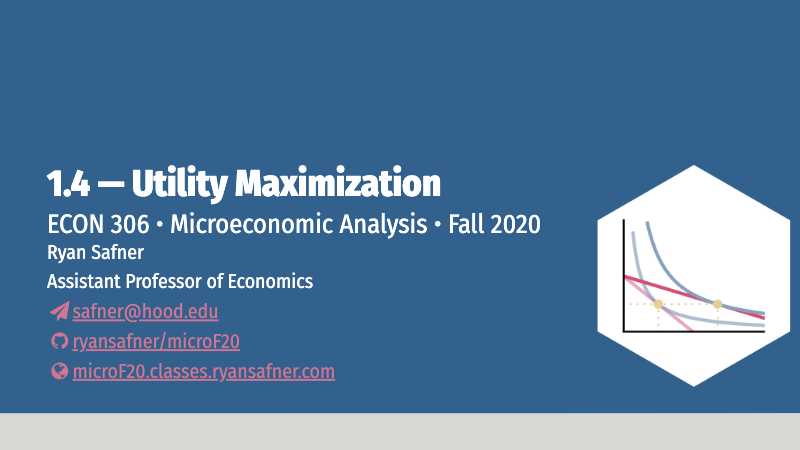1.4 — Utility Maximization — Class Content
Contents
- Section 1: Wednesday, February 10, 2021
- Section 2: Thursday, February 11, 2021
Overview
Today we put all of our tools together thus far to solve the consumer’s constrained optimization problem. To solve the problem the “traditional way” would be to use Lagrangian multipliers and calculus and solve for the first order conditions.Take the full Lagrangian equation and solve for all partial derivatives, set equal to 0.
We instead will find the solution by looking graphically, and use an algebraic rule that should make a lot of intuitive sense. That rule, equivalently expressed in two ways:
MUxMUy=pxpyMUxpx=MUypy
The second (version of the) rule, solved for x and y terms on either side, shows that the marginal utility per dollar spent is equal across both (all) goods.
Both forms are often called the equimarginal rule, that at the optimum choice, the marginal benefit equals the marginal cost (which is the marginal benefit of the next best foregone opportunity).
We will do some practice to make sure you can solve this type of model, and then you are fully prepared for Problem Set 1.
Readings
- Ch. 4.4-4.5 in Goolsbee, Levitt, and Syverson, 2019
- Math Review Guide
Slides
Practice
Today we will be working on practice problems. Answers will be posted later on that page.
Assignments
Problem Set 1 Due Wed Feb 17
Problem set 1 (on 1.1-1.4) is due by 11:59 PM Wednesday February 17 by PDF upload to Blackboard Assignments.
Math Appendix
Solving the Constrained Optimization Problem with Calculus
Example
A consumer has a utility function of
u(x,y)=xy
The problem can be expressed as
maxx,yxy
There are a few strategies you can use to solve this problem using calculus.
Substitution Method: take the budget constraint and solve it for one good in terms of the other good and income. Let’s solve for x:
5x+10y=50The budget constraint5x=50−10ySubtracting 10y from both sidesx=10−2yDividing both sides by 5
Now we can plug this in for x in the utility function to get an unconstrained maximization problem:
maxy(10−2y)yPlugging into the original utility functionmaxy10y−2y2Distributing the y
Then we take the derivative with respect to y and set it equal to zero to find the maximum value of y in the function.
u=10y−2y2The new utility functiondudy=10−4y=0Taking the first derivative10=4yAdding 4y to both sides2.5=yDividing both sides by 4
Now that we know y is 2.5. To find x, plug 2.5 in for y in the first equation we found from the budget constraint:
x=10−2yThe equationx=10−2(2.5)Plugging in 2.5x=10−5Distributing the -2x=5Simplifying
So we’ve found the optimal bundle is 5 of x and 2.5 of y, or (x∗,y∗)=(5,2.5).
Lagrangian Method: Recall the Lagrangian adds the objective function and the Lagrange multiplier (λ) times the constraint set equal to 0:
maxx,y,λΛ(x,y,λ)=xy+λ(5x+10y−50)
Solving for the First Order Conditions (setting all partial derivatives to 0):
∂Λ∂x=y+5λ=0∂Λ∂y=x+10λ=0∂Λ∂λ=5x+10y−50=0
Taking the first two equations, and rearranging each to equal λ:
y5=λx10=λ
Setting them equal to one another, and solving for x:
y5=x102y=x
So the consumer will buy twice the amount of y as x (note this should be intuitive as y costs twice as much as x!). To find the exact amounts of x and y she will buy, plug what we just found into the budget constraint:
5(2y)+10y=5020y=50y=2.5
Since we now know y∗, we can find x∗:
x=2yx=2(2.5)=5
So the optimum consumption bundle (x∗,y∗) again is (5,2.5).
You may be asking: so what in the world is λ? Besides being instrumental in solving constrained optimization problems, the Lagrangian multiplier λ does have some economic interpretation. First, let’s return to the FOCs, knowing x and y, to solve for λ:
y+5λ=02.5+5λ=0λ=0.5
Mathematically, it can be proved that λ=∂u(x,y)∂m: the rate of instantaneous change in your objective function with respect to your constraint (i.e. your income). That is, if you were to change your constraint (i.e. your income) by one unit, λ tells us how much your objective function would increase (in units of the objective function).
Economically, it is known as the “shadow price,” or sometimes the “marginal utility of wealth.” It tells us how much your utility would increase if you were able to increase your constraint (income) by one unit (e.g. $1). Alternatively, we can think of it as the marginal benefit of relaxing the constraint (having $1 more to spend), or the marginal cost of strengthening the constraint (having $1 less).
In our example, λ=0.5, so if we had one +(-)$1 in income to spend, utility would increase(decrease) by 0.5.
Recall that since utility is ordinal and not cardinal, the number of “utils” your utility were to change by is meaningless. λ does have meaningful quantitative interpretations when we use constrained optimization to talk about production, where units are dollars and output, rather than dollars and utility.
Let’s lastly confirm that this is the optimum using the definition
|MRS|=|pxpy|At the optimum, slopes of I.C. and B.C. are equalMUxMUy=pxpyDefinition of each slopeyx=pxpyMU's for this specific utility function(2.5)(5)=510At optimum, y=2.5,x=512=12✓
General Case for n Goods & Marshallian Demand Functions
In the case of n number of goods (from good x1 to xn), the optimal consumption portfolio solves the utility maximization problem:
maxx1,⋯,nnU(x1,⋯,xn) s.t.∑ni=1xipi≤m
That is, as usual, choosing the consumption bundle that maximizes utility, subject to the budget constraint.
Using the Lagrangian method, the Lagrangian is:
L=U(xi,⋯,xn)+λ(M−n∑i=1xipi)
The first order conditions are a series of n+1 equations, with n+1 unknowns:
∂u∂x1=λpi⋮∂u∂xn=λpnn∑i=1xipi=m
Solving for each individual x∗i gives us a Marshallian Demand System:
x∗1=xM1(p1,⋯,pn,m)⋮x∗n=xMn(p1,⋯,pn,m)λ∗=λM(p1,⋯,pn,m)
Each equation here is a demand function for that respective good, as a function of all market prices (p1,⋯,pn) and income m.
